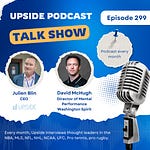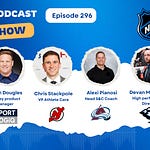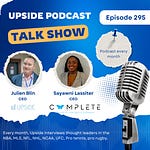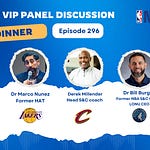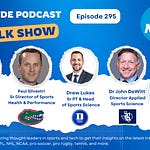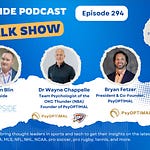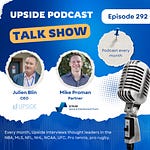This week we have the honor to interview a group of NFL sports performance executives to talk about the latest trends in the world of sports performance, load management, sleep/recovery management, rehabilitation and data & wearable tech integration, and mental performance in the NFL.
Ted Rath, Director of sports performance, New Orleans Saints (NFL team).
Ryan Juarez, Director of rehabilitation, Washington Commanders (NFL team).
Roderick Moore Jr, coordinator of sports science, Pittsburgh Steelers (NFL team).
📝Show Notes: Through this interview, we touched on the best practices related to:
Load Management & Injury Prevention.
Performance Training Innovations.
Rehabilitation & Return to Play.
Sleep & Recovery Management.
Data & Wearable Tech in Decision-Making.
Psychological & Mental Performance.
You can read the full transcript of the podcast interview located at the top of this blog post.
Here are some of the best quotes of our conversation with Ted, Ryan and Roderick:
Q1: Load Management and Injury Prevention
Roderick Moore Jr.:
"You have to be diligent and tactical in your approach to load management. There’s a fine line between providing enough work for the athlete and ensuring enough recovery. It’s an art of coaching. We use tools like Catapult and velocity-based training to track and balance workloads. But ultimately, it’s about education—helping athletes understand recovery, hydration, and regeneration. Listening to the athlete is just as important as looking at the data."Ted Rath:
"We have to marry the psychological stress with the physiological stress. When we talk about workload, it’s not just about what happens on the field. It’s also about how we load them in the weight room, how we tax them mentally in meetings, what time we bring them in, and how we structure their entire day. If a player is mentally overwhelmed, their stress hormones—like cortisol—can spike, which directly impacts injury risk. True workload management is about integrating everything: physical, mental, and emotional stressors, so that players are prepared but not overburdened."Ryan Juarez:
"It's all about communication and alignment with the coaches, the GM, and the players. Buy-in is critical—some guys want a day off, while others feel they need to practice to perform at their best. It’s important to educate them that sometimes less is more. I came from a background where I didn’t know much about load management, and initially, I was skeptical. But seeing the science and data in action has completely changed my perspective. When done right, load management isn’t about holding guys back—it’s about making sure they’re ready to perform when it matters most."
Q2: Advancements in Performance Training
Ted Rath:
"With tools like the 1080 Sprint and velocity-based training, we’re getting closer to a bullseye with every decision we make. The data allows us to program specifically for each athlete and ensure training is individualized. For example, if we see from a 505 test that a player isn’t decelerating well off his left side, we can tailor his training to correct that. At the same time, football is still a power sport, and we can’t lose sight of that. We still need to develop body armor and toughness, and we use data to reinforce those principles rather than replace them."Roderick Moore Jr.:
"Athletes today are smart. They research the tools we use—force plates, GPS, NordBoard—and they ask questions. That curiosity and understanding lead to better buy-in. If a player knows why he’s doing something, he’s more likely to engage fully. One tool we use is the 360-degree belt, which helps bridge the gap between weight room strength and on-field performance. Strength is great, but if it’s not functional, it won’t translate to the game."Ryan Juarez:
"At first, I was skeptical about all the new technology, but now it’s become second nature. The NordBoard has been a game-changer for monitoring hamstring strength, and velocity-based training has helped us tailor workouts for each athlete. What I love most is how these tools create accountability. When a player sees his numbers improving—or sees that he’s lagging behind—it pushes him to take ownership of his own development. That’s something that didn’t exist to this extent a decade ago."
Q3: Return-to-Play Protocols
Ryan Juarez:
"The biggest challenge is making sure players come back safe, fast, and at a high level of performance—without sacrificing one for the other. With the latest tech, we can now objectively track progress and avoid premature returns. In the past, return-to-play decisions were based on how the player ‘felt’ and what we could observe. Now, we have data from force plates, GPS, and NordBoard tests to confirm whether their strength, speed, and mechanics are truly back to pre-injury levels. It’s not just about whether they can run—it’s about whether they can perform at game speed without hesitation or risk of re-injury."Roderick Moore Jr.:
"Having clear KPIs—whether it’s force plate data, GPS metrics, or strength tests—helps us ensure a player is truly ready. We don’t want the game to be their first exposure to max effort after an injury. That’s why we integrate controlled sprinting and game-speed movements into their rehab. If a guy needs to hit 90% of his max sprint speed weekly, we make sure that happens before he ever steps back onto the field. The worst thing we can do is let a player return to competition without replicating the demands of the game in rehab."Ted Rath:
"Marrying performance science with medical return-to-play strategies has been a major evolution. Players today can see their data, understand it, and trust the process more than ever. In the past, a guy might push to return too early because he ‘feels good,’ but now we can show him objective markers that tell him whether he's truly ready. That transparency creates trust, and trust is everything when it comes to return-to-play decisions."
Q4: Sleep and Recovery
Ted Rath:
"The most important technology for sleep and recovery is my communication skills. If I can convince our head coach to alter the schedule for better recovery, that’s more valuable than any device. Players aren’t robots—we need to consider things like travel schedules, night games, and personal stressors. You can track all the sleep data you want, but if you’re not adjusting schedules and workloads accordingly, it won’t matter. True recovery starts with organizational buy-in, and that begins with communication."Roderick Moore Jr.:
"Sleep is free, and it’s the best recovery tool we have. But beyond that, we look at everything—pillow preferences, wearable sleep trackers, and even light exposure before bedtime. A guy might be getting seven hours of sleep, but if it’s low-quality sleep, he’s still not recovering properly. We take a holistic approach to ensure players are not just resting, but actually recovering."Ryan Juarez:
"Education is key. Players need to understand how sleep impacts their performance. Sometimes, it’s as simple as telling a guy to put down the video game and get to bed. If a guy comes in looking exhausted, we adjust his workload for the day and have a conversation about his habits. Little changes—like improving sleep hygiene—can have massive impacts on long-term performance."
Q5: Wearable Tech and Data Analytics
Roderick Moore Jr.:
"Most teams now use real-time GPS tracking in practice to monitor workload and prevent overtraining. Players today want to know their numbers—they ask about their sprint speeds and workload, and that engagement helps us keep them healthy. When a guy knows he’s close to his limit, he understands why we’re making adjustments to his workload rather than just feeling like we’re holding him back for no reason."Ryan Juarez:
"For return-to-play, GPS has been massive. It allows us to gradually ramp up players while keeping them accountable—if they’re hesitant, we show them the numbers and say, ‘Look, you’ve hit your targets, you’re ready.’ That’s powerful because it eliminates doubt and builds confidence."Ted Rath:
"We cannot track live data in NFL games due to competition rules. This is a competitive advantage issue set at the league level, so every team has to wait until the following morning to access the game data. However, in practice, we can track real-time metrics, and that’s where the real value is. If we see a player’s workload is too high, we can adjust on the spot. It’s about using this data to make informed decisions, whether it’s reducing fatigue, preventing injuries, or optimizing performance. The key is not just collecting data—it’s knowing how to apply it effectively to each individual athlete."
Q6: Psychological and Mental Performance
Ted Rath:
"The best way to develop mental resilience is to put players in controlled environments and let them fail. The Navy SEALs do this, and we do it in football—because if they can handle adversity in practice, they’ll be ready for it in the game. Whether it’s simulating crowd noise, chaotic situations, or unexpected changes in play, we stress our players in training so that the real thing feels easier."Roderick Moore Jr.:
"We are all part-psychologists in our roles. Sometimes players won’t open up to the sports psych, but they’ll talk to a coach, trainer, or teammate. Building trust is key. If a guy is dealing with off-field stress—like a newborn baby at home—it’s our job to support him, not just as a player, but as a person."Ryan Juarez:
*"It’s a mental game, and the guys who last the longest are the ones who can handle pressure and adversity. One thing I’ve seen across teams is how mental training is becoming more intentional—whether it’s putting players in high-pressure situations during practice or using visualization techniques to prepare for key moments.
You may also like:
🔥Upside NHL Group Chat with Alexi Pianosi (Colorado Avalanche), Chris Stackpole (NJ Devils), Adam Douglas (Penguins)
This week we have the honor to interview a group of NHL sports performance executives to talk about the latest trends in the world of sports performance, load management, sleep/recovery management, rehabilitation and data & wearable tech integration, and mental performance in the NHL.
🔥Upside Chat with Chris Chase (Memphis Grizzlies/NBA), Dr Marco Nunez (ex LA Lakers/NBA), Dr Andy Barr (Quantum Performance), Derek Millender (Cleveland Cavaliers /NBA).
This week we have the honor to interview again a group of NBA sports performance executives:
🔥Upside Chat with Dr Marco Nunez (ex Lakers/NBA), Adam Quigley (MLS/NFL), Alexi Pianosi (Colorado Avalanche/NHL) on Research & Practical Applications, Technologies Evolution, Gen AI 2.0, VAR & More
This week we had the honor to interview again a group of sports performance experts.







